Adoptee arrives in the home he doesn’t know
A man who was adopted from South Korea by Americans when he was three years old landed on Thursday in his native country - one that is completely unknown to him - after he was deported from the United States, an official and his lawyer said. U.S. Immigration and Customs Enforcement had ordered Adam Crapser deported because of criminal convictions, including assault and being a felon in possession of a weapon. His life story highlights the failings of an adoption system that put him in the homes of one set of parents who abandoned him and another that physically abused him and other adopted children, his Seattle attorney, Lori Walls, told The Associated Press in a telephone interview.
ICE spokeswoman Rose Richeson told AP in an email that the 41-year-old Crapser arrived in Seoul on Thursday morning aboard a commercial airline flight escorted by ICE deportation officers. Richeson said Crapser was arrested by ICE on Feb. 8 after serving a 60-day sentence for menacing constituting domestic violence and attempted coercion. He had been held in an immigration detention center in Tacoma, Washington since then. A judge could have allowed Crapser to stay in America but decided on deportation. Crapser’s supporters said he waived an appeal because he couldn’t stand the detention center any longer. Walls said she is astonished that the fact that Crapser “was adopted, abandoned and abused ... carried relatively little weight in the decision that the immigration court made.” “The U.S. government facilitated the adoption out of Korea,” she said. “No one followed up to make sure he was safe. When that first family abandoned him to foster care he was not visible - there was no follow-up.”
No one ever sought U.S. citizenship for him. He and his older sister were adopted by a family who lived in Michigan and who later abandoned them after they moved to Oregon, Walls said. Brother and sister were split up. Crapser was eventually adopted by parents in Oregon who assaulted him and other children in their care. His adoptive parents were convicted of multiple crimes. Crapser eventually left the home and was arrested after he broke in to retrieve some of his belongings from his orphanage in South Korea, Walls said. Crapser later got into further trouble with the law. He came under the scrutiny of federal immigration authorities after he applied for a Green Card and they saw his criminal record. “I’m hopeful Adam figures out how to make a life in that country, where he doesn’t speak the language, read the language or know anything about the culture,” Walls said.
His birth mother in South Korea, who had put her son and daughter up for adoption because she couldn’t afford to keep him, is learning English so she can communicate with him when they’re reunited, The New York Times reported recently. “His birth mother, because of publicity in South Korea, came forward,” Walls said, adding that a DNA test proved the relationship. Walls noted that the mother is disabled, has a low income “and can’t be much help for him.” “I spoke with Adam a couple of days ago,” Walls said. “He was trying to stay positive, but I mean it was clear talking to him that he was scared. He’s going to a country where he can’t even read the street signs.” Walls said there might be legal remedies for Crapser to return to the U.S. but that it would be “an uphill battle.”

'Study > English' 카테고리의 다른 글
| Thailand Today (0) | 2016.11.25 |
|---|---|
| China closes door on Korean entertainers (0) | 2016.11.24 |
| Trade agency details 2017 trends: China and green (0) | 2016.11.22 |
| Korean start-ups lacking diversity (0) | 2016.11.21 |
| A Different Kind of Fantasy (0) | 2016.11.18 |
たれる: 타레루 (늘어지다 / 내리다)
よだれがたれる。: 침이 늘어지다.
幕(まく)がたれる。: 막이 드리워지다.
ソースがたれてしまった。: 소스를 흘려버렸다.

'Study > Japanese' 카테고리의 다른 글
| うごく (動く): 우고쿠 (움직이다) (0) | 2016.11.24 |
|---|---|
| たく (炊く): 타쿠 ((밥을) 짓다 / 삶다 / 익히다) (0) | 2016.11.23 |
| にく (肉): 니쿠 (고기) (0) | 2016.11.21 |
| かぞえる (数える): 카조에루 (세다) (0) | 2016.11.18 |
| つまらない: 츠마라나이 (재미없다) (0) | 2016.11.17 |
Trade agency details 2017 trends: China and green
The elimination of China’s decades-old “one child” policy is expected to create new opportunities for Korean toy and children’s product makers, while the worldwide emphasis on environmental protection is expected to generate more demand for electric cars and environmentally-friendly buildings, which could benefit Korean manufacturers. These are just some of the strategies and trends outlined in the Korea Trade-Investment Promotion Agency’s annual report for how Korean companies can take advantage of newly emerging opportunities across the world next year, based on data collected from its 33 trade offices in different countries.
The end of China’s population control policy, perhaps the most infamous in the world, in 2015 is expected to be a boon for Korean manufacturers of children’s products, as the younger population of its giant neighbor will grow in coming years. “As the safety of children’s products made in China is dubious after the melamine-tainted powdered milk scandal [in 2008], parents are looking for quality import products,” said Ro Hyun-joo, who works at the Korean trade agency’s Hangzhou office in southeastern China. As China’s third-largest trading partner, Korea has a good chance of banking on the opportunity. Exports of Korean children’s products amounted to $230 million in 2015, a jump of 5.8 times from five years prior, according to data from the Korea Customs Service. “The popularity of Korean pop culture in China and the influence of successful television programs like ‘Dad! Where are We Going?’ [a reality show where children and their fathers go on trips together] may have spurred Chinese interest for Korean child care goods,” Ro said.
Prospects are also good for Korean companies hoping to enter countries like Paraguay, the Philippines and Vietnam, the report said. In particular, Paraguay’s “Maquila Program,” which allows foreign factories to import certain materials and equipment tariff-free and then export finished goods, is a notable business opportunity that could help Korean companies’ entry into Latin American markets. In terms of worldwide trends, the trade agency pointed to increasing demand for environmentally-friendly products, including electric bicycles, vehicles and green buildings. Germany, with its strong automakers, has accelerated development of electric cars. Volkswagen is working toward releasing over 20 electric vehicle models by 2020 and replacing 25 percent of its cars with electric ones.
Korean automakers Hyundai Motor and Kia Motors have released the Ioniq and Niro but they are still in the early stages of development. Korea itself lacks the infrastructure to ramp up development. While there are around 80,000 electric vehicles registered in Korea, the number of fast charging stations nationwide is less than 500 units. Compared to the United States, where there are 6.6 vehicles per charging station, and China, where the number is 3.8, there are a whopping 17 electric vehicles per station in Korea. “Koreans have a competitive edge in battery-making technology and so we expect Korean companies to leap into the electric mobility business in the future,” said Lee Ho-bin, a Korea Trade-Investment Promotion Agency employee in Germany.
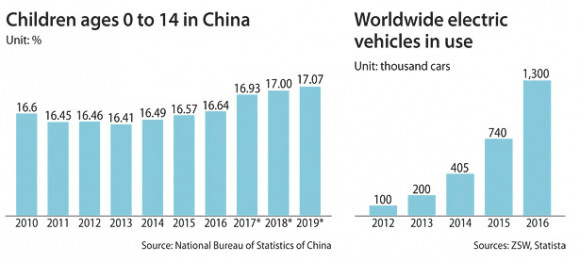
'Study > English' 카테고리의 다른 글
| China closes door on Korean entertainers (0) | 2016.11.24 |
|---|---|
| Adoptee arrives in the home he doesn’t know (0) | 2016.11.23 |
| Korean start-ups lacking diversity (0) | 2016.11.21 |
| A Different Kind of Fantasy (0) | 2016.11.18 |
| Cho secures her first season title at KLPGA (0) | 2016.11.17 |
にく (肉): 니쿠 (고기)
肉(にく)が大好(だいす)きです。: 고기를 매우 좋아해요.
豚肉(ぶたにく)より牛肉(ぎゅうにく)の方(ほう)が好(す)きです。: 돼지고기보다 소고기를 좋아해요.
肉(にく)を焼(や)く。: 고기를 굽다.
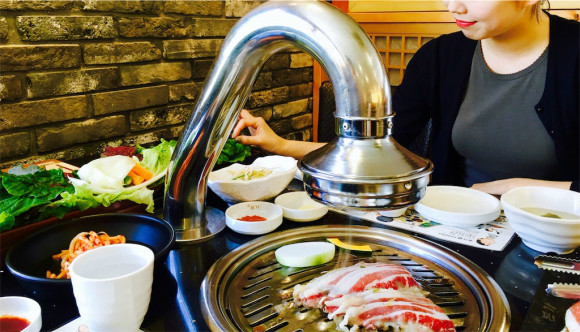
'Study > Japanese' 카테고리의 다른 글
| たく (炊く): 타쿠 ((밥을) 짓다 / 삶다 / 익히다) (0) | 2016.11.23 |
|---|---|
| たれる: 타레루 (늘어지다 / 내리다) (0) | 2016.11.22 |
| かぞえる (数える): 카조에루 (세다) (0) | 2016.11.18 |
| つまらない: 츠마라나이 (재미없다) (0) | 2016.11.17 |
| かくにん (確認): 카쿠닝 (확인) (0) | 2016.11.16 |
Korean start-ups lacking diversity
Korea’s start-up scene lacks diversity in gender and nationality compared to the world’s leading regions for start-ups and innovation, according to a study on Korean start-ups. Women are just 9 percent of start-up founders in Korea, versus 24 percent in Silicon Valley, 20 percent in Tel Aviv and 19 percent in Singapore, according to a white paper released Wednesday by the Korean Startup Ecosystem Forum, a private think tank. Gender imbalance is rampant worldwide, even in Silicon Valley where just 10 percent of founders of so-called high-growth firms are women. But start-ups in Korea hire more women than other cities. Female employees make up 32 percent of Korean start-ups, while just 29 percent in Silicon Valley and 24 percent in London. “Despite low entrepreneurship among women, overall participation of women in Korean start-ups is at a globally competitive level,” said Lee Ji-eun, professor of business information at Hanyang Cyber University and one of the co-authors of the study, at a news conference Wednesday at Google Campus Seoul.
The white paper is based on surveys and interviews with 295 start-ups in Seoul and Gyeonggi. The results were compared with four other technologically advanced regions, or start-up hubs. Foreign participation in the Korean start-up ecosystem is much lower than in the other locations. Whereas London start-ups fill as much as 53 percent of their workforce with non-British nationals, and the percentage in Singapore stands at 52 percent, just 17 percent of Korea’s workforce is foreign. Korean regulations that place a 20 percent cap on the number of international employees in any company and a complicated and difficult visa system limits international diversity, the study says. These factors have been previously noted by countless entrepreneurs and experts who have pointed out that President Park Geun-hye’s administration has set “creative economy” as a key policy imitative but hasn’t eased regulations for foreigners. Investments in Korean start-ups, however, have risen in the past two years. The number of rounds of investments made in start-ups that are less than a year old increased 73 percent to 88 and investments in two- to three-year-old start-ups also rose 81 percent to 62.
“Korea’s start-up ecosystem has grown rapidly in the past four years,” said Hwang Byung-sun, managing director of Big Bang Angels and co-editor of the study. “China and Southeast Asia have been posting growth but Korea doesn’t fall behind. But the excellence of our ecosystem isn’t that much publicized internationally, which led us to publish this white paper.” The study shows that the average start-up entrepreneur in Korea is a man in his 30s who has an engineering degree, is fluent in English and had at least five years’ work experience. More entrepreneurs with degrees at the master’s level or above have joined start-ups this year. The percentage of master’s degree holders is now 25 percent, up from 15 percent two years ago, and those with doctorate degrees more than tripled to 10 percent in the same time frame. In Silicon Valley, the percentage of master’s degree holders was 30 percent and doctorate degree holders was 10 percent in 2014, the latest year data was available for. The cost of launching a start-up in Korea is $27,000 and the number of starting members is 2.78 on average. It takes about four years for a start-up to receive a Series A investment, or the first round of venture capital financing.
By region within Seoul and Gyeonggi, Gangnam in southern Seoul, accommodated the largest portion of start-ups at 39 percent, followed by Seongnam in Gyeonggi at 22 percent. “Gangnam is where the investment and networking are,” said Back Sang-hoon, professor of digital media at Kyungsung University and one of the study’s co-authors. “Over 3,000 start-up related events take place a year and 81 percent of all venture capital firms are located in Gangnam."
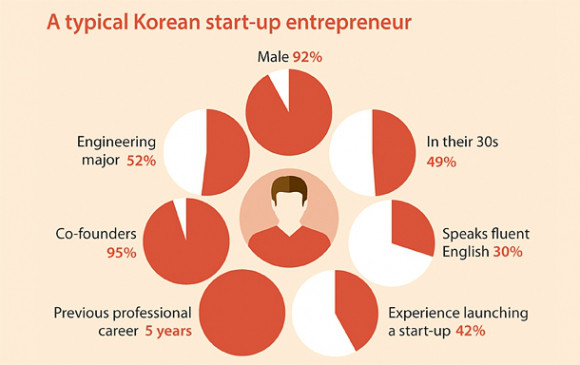
'Study > English' 카테고리의 다른 글
| Adoptee arrives in the home he doesn’t know (0) | 2016.11.23 |
|---|---|
| Trade agency details 2017 trends: China and green (0) | 2016.11.22 |
| A Different Kind of Fantasy (0) | 2016.11.18 |
| Cho secures her first season title at KLPGA (0) | 2016.11.17 |
| Trump affirms U.S.-Korea alliance (0) | 2016.11.16 |
かぞえる (数える): 카조에루 (세다)
数(かぞ)えてごらん。: 세어보렴.
数(かぞ)えきれない思(おも)い出(で)がたくさんある。: 셀 수 없을 추억이 많이 있다.
数(かず)を数(かぞ)える。: 수를 세다.
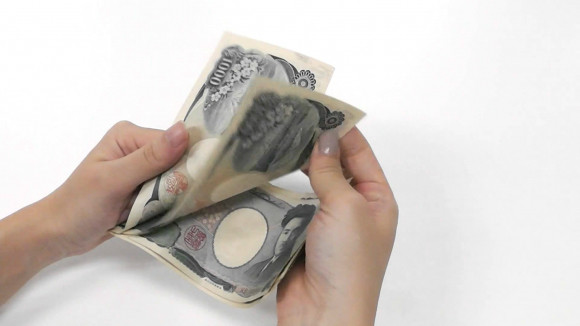
'Study > Japanese' 카테고리의 다른 글
| たれる: 타레루 (늘어지다 / 내리다) (0) | 2016.11.22 |
|---|---|
| にく (肉): 니쿠 (고기) (0) | 2016.11.21 |
| つまらない: 츠마라나이 (재미없다) (0) | 2016.11.17 |
| かくにん (確認): 카쿠닝 (확인) (0) | 2016.11.16 |
| いう (言う): 말하다 (이우) (0) | 2016.11.14 |
A Different Kind of Fantasy
“E.T. the Extraterrestrial,” “Avatar,” “The Martian,” “Artificial Intelligence,” and “Jurassic Park” are only some of the most famous science-fiction or sci-fi movies that tickled the imagination of audiences. They are popular because they take viewers to a different realm that is not as enchanted or bizarre as the supernatural world. They provide a suspension of disbelief long enough to leave audiences entertained.
Science fiction is a subgenre of speculative fiction, a broader category that involves elements, settings, and characters created out of imagination and speculation far from reality and everyday life. Sci-fi usually tackles the possible consequences of scientific and other innovations. The imagined aspects of sci-fi movies include futuristic science, space travel, time travel, faster than light travel, parallel universe, and extraterrestrial life.
Writers usually base their writing on alternative worlds or possible futures, but they are not the same as worlds portrayed in fantasy movies and stories. The fictional element of science fiction stories are based on scientifically established physical laws or hypothesized ones.
Science fiction originated in the 1600s. However, some authors argue that the first true works of science fiction are Mary Shelley’s “Frankenstein” and “The Last Man.” Edgar Allan Poe, another celebrated author, wrote a story about a flight to the moon. Following these works, many examples of science fantasy have emerged all throughout the century.
Science fiction has two categories. One is hard science fiction which pays attention to physics, astrophysics, and chemistry. Films of this category include “Gravity” and “The Martian.” The other is soft science fiction which is characterized by its focus on social sciences such as psychology, economics, political science, sociology, and anthropology. Examples of soft science fiction films are the “Planet of the Apes” franchise, the “Star Trek” franchise, and “Terminator.”
Aside from the two categories, science fiction also has several subgenres. A famous subgenre is time travel which is very common in films. Time travel stories focus on the consequences of traveling into the past or the future. Good examples time travel theme are “Inception” and “Interstellar.” Other subgenres are alternative history, space opera, climate fiction.
Science fiction as a category of literature is still a growing genre in South Korea. To date, there are only a few science fiction writers, but the number is growing.

'Study > English' 카테고리의 다른 글
| Trade agency details 2017 trends: China and green (0) | 2016.11.22 |
|---|---|
| Korean start-ups lacking diversity (0) | 2016.11.21 |
| Cho secures her first season title at KLPGA (0) | 2016.11.17 |
| Trump affirms U.S.-Korea alliance (0) | 2016.11.16 |
| Fusion Cuisine in the Food Scene (0) | 2016.11.15 |
つまらない: 츠마라나이 (재미없다)
あ~ つまらない。: 아~ 재미없어.
彼(かれ)の話(はなし)はつまらない。: 그의 이야기는 지루하다.
彼女(かのじょ)はつまらない人(ひと)で、一緒(いっしょ)にいたくない。: 그녀는 재미없는 사람이라, 같이 있기 싫다.

'Study > Japanese' 카테고리의 다른 글
| にく (肉): 니쿠 (고기) (0) | 2016.11.21 |
|---|---|
| かぞえる (数える): 카조에루 (세다) (0) | 2016.11.18 |
| かくにん (確認): 카쿠닝 (확인) (0) | 2016.11.16 |
| いう (言う): 말하다 (이우) (0) | 2016.11.14 |
| はいる (入る): 하이루 (들어가다) (0) | 2016.11.11 |
Cho secures her first season title at KLPGA
Cho Yoon-ji, a Korean professional golfer in her eighth year at the KLPGA, claimed her first season title on Sunday at the ADT CAPS Championship 2016. During the final round of the ADT CAPS Championship, the final championship of the season, which took place on Sunday at the South Spring Country Club in Incheon, Cho shot 4-under to wrap up the entire event 11-under 205. Cho, an overnight leader who was ahead by two shots after the second round on Saturday, started out the day strong on Sunday, carding three straight birdies from the first to third hole. Although she hit a brief bump at the seventh where she took a bogey, the win from the championship looked guaranteed for the golfer.
Even at the 15th, when her ball trickled into a hazard, she still managed to remain at the top, nabbing a par despite the difficulty. She then almost recorded an eagle on the next hole, but settled for a birdie instead. But others steadily narrowed the gap between them and the leader, and by the latter half of the day, Cho was ahead only by one shot. At the final hole, Cho’s tee shot fell into a bunker, which allowed one of the runners-up, Lee Min-young, who was tied at second then, to catch up. But fortunately, Cho’s second shot fell through and found the green while Lee’s approach shot landed just outside the green. Cho’s birdie putt, a long way from home, came up short of the pin, still leaving a slim chance for Lee to tie the match and force the tourney into a playoff. Lee would still be able to take a crack at the title if she nailed a birdie approach. Instead of a wedge, she chose a putter and took a shot beyond the green but eventually failed to tally a birdie, giving Cho a clear line of sight between herself and the trophy.
Cho capitalized on the chance by sinking in the par putt to finish the competition at the top of the leaderboard, marking her third career win. During the Winner’s Interview after the tournament, Cho said, “I didn’t even think of winning the title. But I do have some good memories from this course so I decided to go at it lighthearted.” During the 2015 E1 Charity Open played on the same course as the ADT CAPS Championships, Cho tallied eight birdies in a row from the first to the eighth hole of the third round. “I got nervous stating at the 15th hole [of the final round] when the ball fell into the hazard,” Cho said. “I may not have shown it but I was really on edge. But I am glad to conclude the event with good results.”
Also at this year’s KLPGA, Ko Jin-young claimed the Player of the Year award, accumulating a total of 562 KLPGA points, one point ahead of the runner-up, Park Sung-hyun. Park, who ended her season at the KLPGA early to prepare herself for the U.S.-based LPGA tour next year, still managed to claim several honors, topping the Official Money rankings as well as the Scoring Average and taking the most number of wins this season. Lee Jeong-eun captured the Rookie of the Year award with a total of 1997 Rookie Point from this year’s KLPGA.
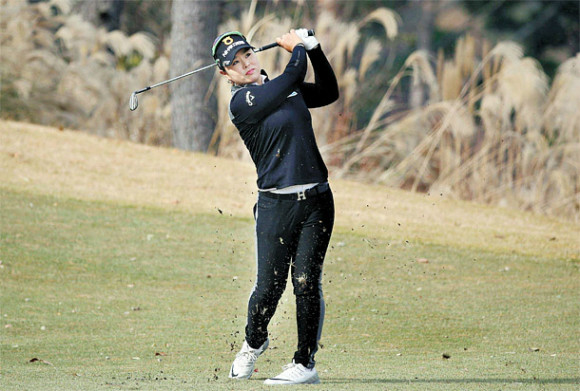
'Study > English' 카테고리의 다른 글
| Korean start-ups lacking diversity (0) | 2016.11.21 |
|---|---|
| A Different Kind of Fantasy (0) | 2016.11.18 |
| Trump affirms U.S.-Korea alliance (0) | 2016.11.16 |
| Fusion Cuisine in the Food Scene (0) | 2016.11.15 |
| Park Sung-hyun to join the U.S. LPGA tour (0) | 2016.11.14 |
かくにん (確認): 카쿠닝 (확인)
もう一回(いっかい)確認(かくにん)してきて。: 다시 한 번 확인하고 와.
ちゃんと確認(かくにん)してないから、こんなことが起(お)きるんだよ。: 제대로 확인하지 않으니까 이런 일이 일어난거야.
真実(しんじつ)を確認(かくにん)したかっただけです。: 진실을 확인하고 싶었을 뿐입니다.

'Study > Japanese' 카테고리의 다른 글
| かぞえる (数える): 카조에루 (세다) (0) | 2016.11.18 |
|---|---|
| つまらない: 츠마라나이 (재미없다) (0) | 2016.11.17 |
| いう (言う): 말하다 (이우) (0) | 2016.11.14 |
| はいる (入る): 하이루 (들어가다) (0) | 2016.11.11 |
| いる (要る): 이루 (필요하다) (0) | 2016.11.10 |
